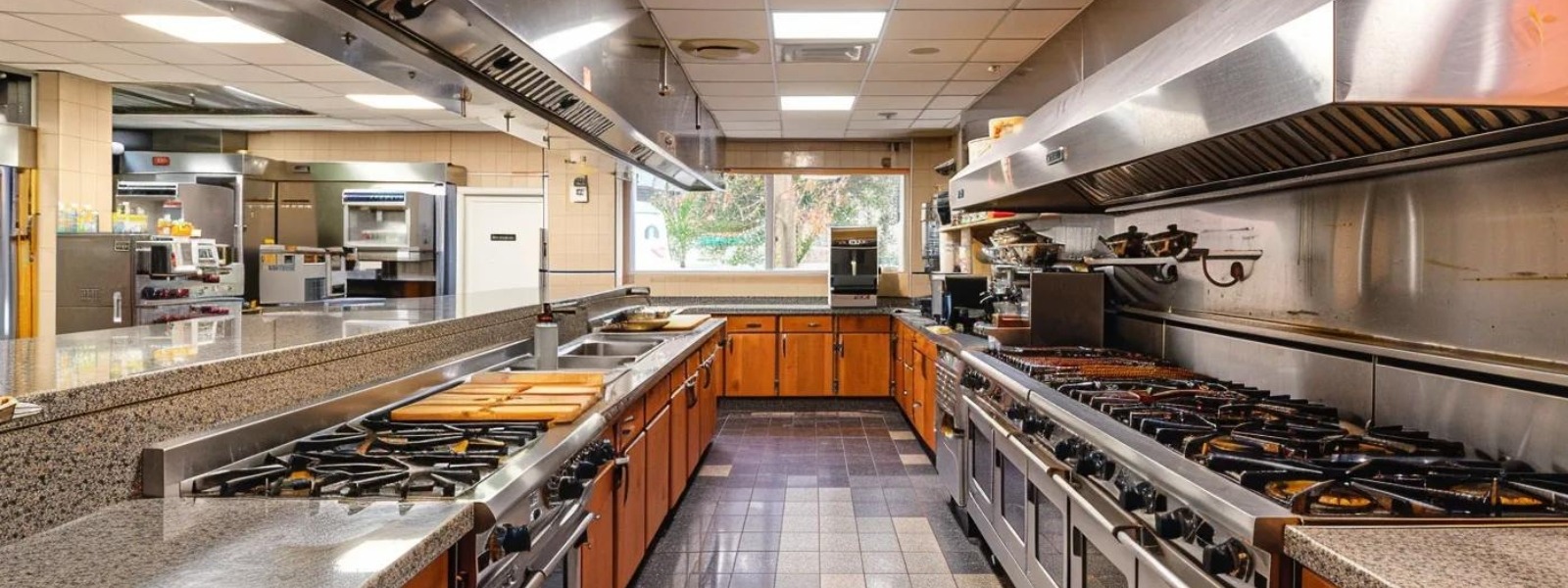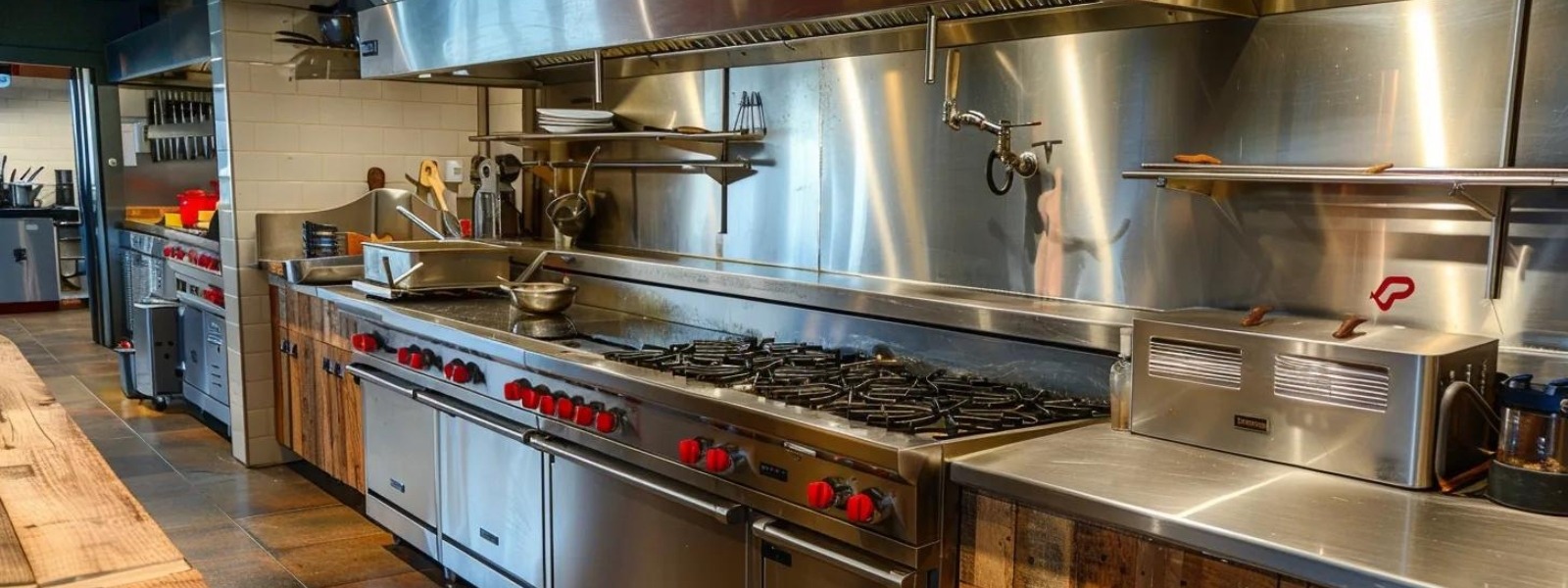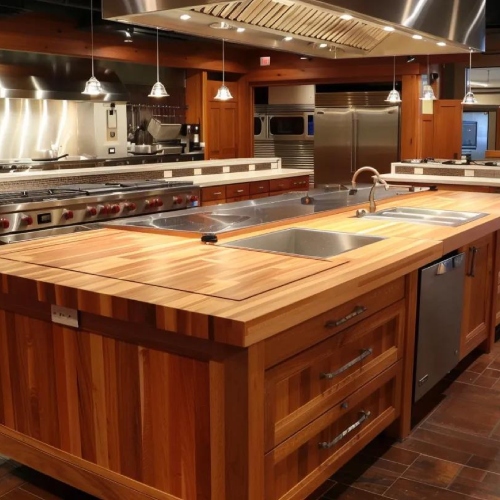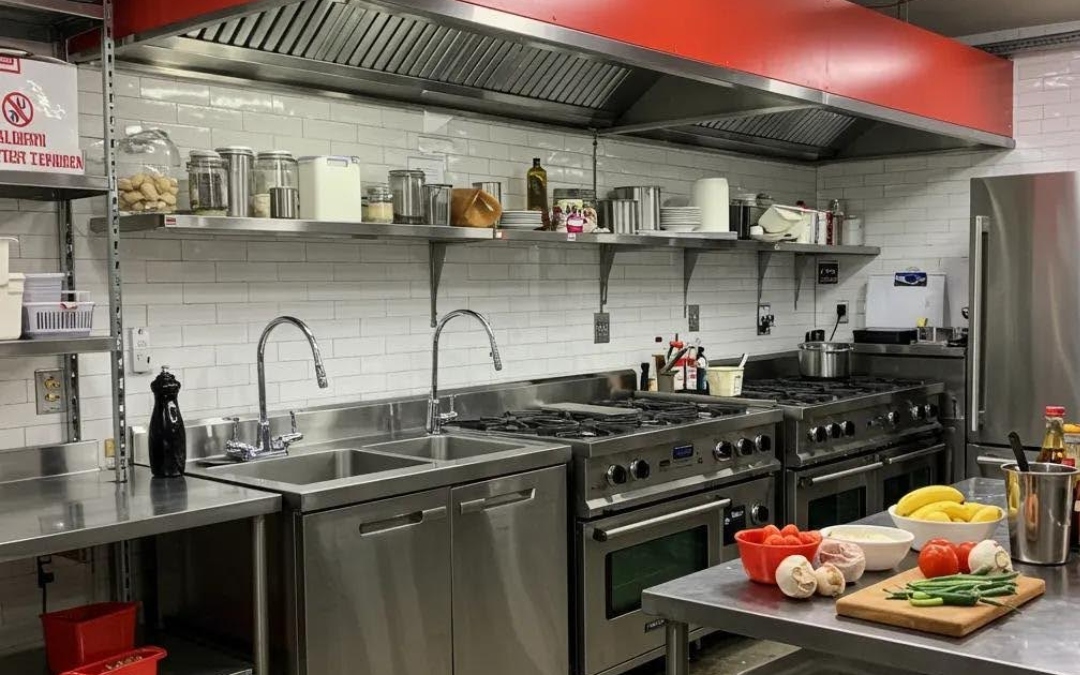Yes, wood cabinets can be used in commercial kitchens if they are sealed and properly coated to resist moisture and bacteria. Health departments allow them in dry or non-food prep areas like storage rooms, offices, or serving stations. Avoid placing them near sinks, dishwashers, or cooking zones where heat and humidity can cause damage or sanitation issues.
What Are the Health Code Requirements for Commercial Kitchen Cabinets?
Health codes require commercial kitchen cabinets to have smooth, sealed, easily cleanable surfaces that prevent bacterial growth. Bare wood fails health inspections in food preparation areas. All cabinet surfaces must withstand daily cleaning with commercial sanitizers.
Surface Material Standards
Health departments prohibit unfinished wood in commercial food establishments. Minnesota health regulations state that unfinished wood cannot contact food or exist in food preparation zones. Denver building codes mandate that all cabinetry must be completely sealed with smooth washable surfaces.
Cabinet surfaces must be non-porous and moisture-resistant, free from cracks where bacteria hide, and cleanable with standard sanitizing solutions. These requirements protect customers from foodborne illness and maintain sanitary conditions throughout food service operations.
The National Sanitation Foundation establishes minimum food protection standards for commercial equipment materials. NSF International has facilitated development of more than 75 standards and protocols for sanitary food equipment used in restaurant settings. Products bearing NSF certification meet strict requirements for material safety, design construction, and cleaning performance.
Installation Height Requirements
Floor-mounted cabinets need 6-inch sanitary legs or sealed bases filled with expandable foam. This prevents pest harborage and allows proper floor cleaning beneath cabinets. Counter-mounted equipment requires 4-inch legs or complete sealing to countertops.
The space beneath cabinets serves an important purpose beyond aesthetics. Cleaning crews must access floor areas under and around storage units. Health inspectors check these spaces during routine visits. Solid bases that rest directly on floors create hiding spots for rodents and insects. Raised cabinets eliminate these problems while making daily cleaning easier for kitchen staff.
All counter surfaces and custom millwork must have smooth washable finishes. Health departments reject installations with exposed wood grain or unsealed surfaces. Cabinet doors need tight fitting construction with minimal gaps. Hollow base construction receives automatic rejection during health inspections. This regulation applies equally to wood cabinets, metal units, and composite materials.
Where Can Wood Cabinets Work in Commercial Kitchens?
Wood cabinets function properly in dry storage rooms, dining areas, bakery stations, and office spaces away from moisture and heat. These zones avoid the constant water exposure and temperature extremes that damage wood. Strategic placement protects wood while meeting health codes.
Safe Zones for Wood Installation
Dry storage rooms provide ideal conditions for wood cabinetry. These areas maintain consistent temperature and low humidity levels. Wood cabinets store packaged goods, canned items, flour, sugar, and paper products without risk of water damage. Many custom pantries feature sealed wood construction because they operate in controlled environments.
Dining and server areas use wood freely because customers never see food preparation. Wood creates warmth and matches restaurant aesthetics. Server stations, host stands, and display units work perfectly with wood construction.
Bakery preparation tables receive special consideration in health codes. Hard maple work surfaces gain approval in bakery zones because these areas remain drier than typical kitchen stations. Manager offices follow different regulations than food zones. Staff can enjoy attractive custom home office cabinetry in management and planning spaces.
Prohibited Areas for Wood Cabinets
Wood fails in dishwashing stations due to constant water exposure. Steam, splashing, and cleaning chemicals destroy wood finishes quickly in these zones. Even marine-grade wood sealants cannot protect against the extreme conditions near commercial dishwashers.
Cooking lines near fryers and grills generate extreme heat that damages wood cabinets. Heat exposure causes protective finishes to break down and compromises structural integrity. Food preparation sinks create moisture problems for any wood installation. Walk-in coolers and freezers subject cabinets to temperature fluctuations that cause wood expansion and contraction.
What Protective Finishes Make Wood Cabinets Code-Compliant?

Marine-grade sealants, food-safe polyurethane, epoxy finishes, and commercial laminates protect wood cabinets from moisture and bacteria. Multiple coating layers create non-porous surfaces that health inspectors approve. Proper finishes transform raw wood into cleanable, sanitary surfaces.
Commercial-Grade Coating Options
Marine-grade sealants represent heavy-duty finishes that prevent water penetration and mold growth. These coatings cost more than standard wood finishes but eliminate future repair expenses from water damage. Marine applications face constant moisture exposure, so these products provide maximum protection for commercial kitchen conditions.
Food-safe polyurethane creates hard washable surfaces when applied in multiple layers. Commercial-grade formulations withstand daily cleaning with sanitizing solutions. Restaurant-grade epoxy fills wood pores and creates smooth non-porous barriers. These finishes meet health department cleanability standards because they eliminate surface texture where bacteria might hide.
Wood veneer with commercial coating combines genuine wood appearance with waterproof protection. Thin wood layers over stable substrate prevent warping while maintaining natural aesthetics. This option costs less than solid hardwood while providing better moisture resistance.
Maintenance Schedule Requirements
Wood cabinets need regular inspection and resealing to maintain code compliance. Daily cleaning with mild soap and water removes surface contamination and prevents buildup. Monthly finish inspections identify chips or cracks before they become serious problems.
Annual or bi-annual resealing depends on usage intensity and moisture exposure. High-traffic restaurants need more frequent refinishing than small cafes. Budget approximately $500 to $2,000 per refinishing session depending on cabinet quantity and finish complexity.
Documentation of maintenance activities helps during health inspections and proves ongoing code compliance. Keep records of original finish products, application dates, and maintenance logs. Inspectors view detailed documentation as evidence of professional operation and serious commitment to sanitation standards.
How Do Wood Cabinets Compare to Stainless Steel?
Stainless steel cabinets resist moisture, heat, and pests better than wood cabinets. Steel surfaces never warp, crack, or absorb water. Wood offers lower initial costs and warmer aesthetics but requires ongoing maintenance. The best commercial kitchens mix both materials based on zone requirements.
Performance Comparison
Wood cabinets cost $200 to $650 per unit for initial purchase and installation. Stainless steel units range from $500 to $2,500 per unit with upgraded features pushing costs to $3,000 and beyond. The price difference reflects material costs, fabrication complexity, and expected lifespan.
Water resistance separates these materials fundamentally. Wood requires sealing and resealing to prevent moisture damage. Steel naturally repels water without any treatment. Heat tolerance gives steel clear advantages near cooking equipment. Wood suffers damage from heat exposure and cannot safely install near fryers, grills, or ovens.
Bacteria growth concerns favor non-porous steel surfaces. Wood grain provides microscopic spaces where bacteria hide even after cleaning. Steel offers smooth surfaces that wipe clean and provide no bacterial harborage. Lifespan differences affect long-term value calculations. Wood cabinets last 5 to 10 years in commercial settings while stainless steel units function for 15 to 25 years with minimal maintenance.
Cost Analysis Over 10 Years
Upfront investment for 20 wood cabinet units totals $6,000 to $30,000 including installation labor. The same quantity in stainless steel costs $10,000 to $50,000 depending on grade and features. Wood appears cheaper initially but maintenance expenses accumulate quickly.
Wood refinishing every 2 years costs $500 to $2,000 per session for professional service. Water damage replacement adds $1,000 to $5,000 when cabinets fail prematurely. Stainless steel maintenance totals under $500 for the entire 10-year period.
Total ownership calculations reveal steel costs less over time despite higher purchase prices. Understanding why kitchen cabinets are expensive helps business owners make informed decisions about material selection and budget allocation.
Which Wood Species Work Best in Commercial Settings?
Maple, oak, cherry, and birch offer durability for commercial kitchen cabinets. Hard maple provides the highest density and scratch resistance. Oak combines strength with attractive grain patterns. These hardwoods withstand daily use better than soft woods like pine or fir.
Top Hardwood Choices
Hard maple achieves the highest density rating among common hardwoods. The tight cell structure resists dents, scratches, and daily impacts. Moisture absorption remains minimal even under challenging conditions. Commercial operations value maple for work surfaces and cabinet construction.
Red oak provides strong construction material with visible grain character. Oak costs less than exotic hardwoods while delivering reliable performance. Cherry develops beautiful reddish tones that darken over time but requires extra sealing layers for moisture protection.
Yellow birch offers cost-effective hardwood with excellent strength properties. Similar hardness to maple at lower prices makes birch attractive for budget-conscious operations. Avoid soft woods like pine, fir, or cedar in commercial applications. These materials dent easily under daily use and lack the density needed for professional service.
What Alternative Materials Look Like Wood?
High-pressure laminate, thermofoil, and wood veneer with commercial coatings provide wood aesthetics with better moisture resistance. These engineered materials pass health inspections more easily than natural wood. Alternative options reduce maintenance while maintaining visual appeal.
Engineered Wood Solutions
High-pressure laminate over plywood cores creates stable water-resistant cabinets. The laminate surface resists scratches and wipes clean easily. Realistic wood grain patterns match natural wood appearance at lower cost. Plywood cores provide superior stability compared to particleboard or MDF substrates.
Thermofoil over MDF uses vacuum-pressed vinyl to completely seal cabinet surfaces. No exposed wood means easier code compliance and simpler cleaning procedures. The budget-friendly option works well for dry storage areas. Heat exposure creates the main limitation for thermofoil products because the vinyl melts under high temperatures.
Commercial wood veneer combines real wood appearance with waterproof coating protection. Thin wood layers over stable substrate prevent warping common in solid wood construction. The coating creates easy-clean surfaces that satisfy health inspectors while maintaining authentic wood character.
How Should Mixed Materials Work in Commercial Kitchens?
Strategic material mixing places stainless steel in high-risk zones and wood in safe areas for optimal performance and cost efficiency. Hot cooking lines need all steel. Cold prep areas accept mixed materials. Dry storage and dining spaces feature wood freely.
Zone-Based Material Selection
Cooking lines representing 60% of kitchen space require all stainless steel construction near stoves, ovens, fryers, and grills. Heat and grease exposure demands maximum durability and fire resistance.
Prep stations occupying 20% of kitchen space benefit from mixed material strategies. Stainless steel countertops over sealed wood base cabinets combine durability with cost control. Dry storage consuming 15% of kitchen space accepts wood cabinets and shelving for bulk ingredients. Restaurants can create attractive organized storage using custom cabinetry solutions designed specifically for dry goods.
Dining areas representing 5% of kitchen space feature wood prominently for customer-facing aesthetics. Server stations, host stands, and display cabinets use wood without restriction.
Cost-Effective Hybrid Design
Blending stainless work surfaces with wood cabinetry creates functional yet attractive commercial kitchens. This approach saves 20% to 30% compared to all-steel installations while maintaining code compliance.
Installation strategy follows logical steps. Map high-risk zones requiring steel based on health department guidelines. Identify safe areas for wood based on moisture exposure and temperature conditions. Calculate budget allocation for each material category. Order materials with proper certifications and specifications.
What Mistakes Should You Avoid with Wood Cabinets?
Common errors include using residential-grade materials, skipping proper sealing, installing wood near water sources, neglecting maintenance, and failing to document compliance. These mistakes lead to health violations, costly repairs, and failed inspections.
Critical Installation Errors
Using home-grade materials represents the most frequent mistake in commercial installations. Residential cabinets lack commercial durability and proper construction techniques. Always specify commercial-grade products designed specifically for food service applications.
Inadequate sealing causes premature cabinet failure and health code violations. Bare wood or poorly sealed surfaces fail inspections immediately. Marine-grade sealants cost more but deliver necessary protection. Multiple coating layers create approved surfaces that satisfy health department requirements.
Wrong zone placement dooms wood cabinets regardless of sealing quality. Wood installed near dishwashers, sinks, and steam equipment warps despite best protective measures. Maintain minimum 3 feet clearance from water sources for any wood installation. Never install wood in walk-in coolers or freezers.
Missing maintenance documentation raises red flags during health inspections. Keep detailed logs of original finishes, resealing dates, repairs, and product specifications. Digital records provide easy access during inspections and prove ongoing compliance efforts.
How Much Do Commercial Kitchen Cabinets Really Cost?
Total cabinet costs include purchase price, installation labor, sealing products, and ongoing maintenance over 10 years. Wood appears cheaper initially but accumulates higher lifetime expenses. Stainless steel costs more upfront but requires minimal ongoing investment.
Complete Cost Breakdown
Budget wood cabinets range from $300 to $800 per unit for basic construction. Premium wood with proper sealing costs $800 to $1,500 per unit including marine-grade finishes. Standard stainless steel units price between $500 and $1,500 per unit. Premium stainless steel reaches $1,500 to $3,000 per unit with custom features.
Installation labor adds significant expense to raw cabinet costs. Wood cabinet installation runs $100 to $200 per unit for standard mounting. Stainless steel installation costs $150 to $300 per unit due to heavier weight and precise alignment requirements.
Annual maintenance for wood includes inspection and routine cleaning at $200 to $500. Stainless steel cleaning totals only $100 to $300 annually. Calculate 10-year ownership costs rather than focusing only on purchase price. Business owners should understand the average cost of custom kitchen cabinets before making material decisions that impact long-term profitability.
What Do Local Health Departments Require?
Health department requirements vary by city, county, and state but generally mandate sealed surfaces, proper installation heights, adequate cleaning access, and pest prevention measures. Contact local inspectors before purchasing cabinets. Written guidelines prevent costly compliance issues.
Regional Regulation Differences
Denver requires 6-inch sanitary legs on floor cabinets and complete sealing of all wood surfaces. California health codes specify non-porous materials in food preparation zones. The state treats health violations as misdemeanors with fines up to $1,000 and potential jail time.
New York mandates food storage at least 6 inches above floor level regardless of cabinet type. Minnesota prohibits unfinished wood in food establishments statewide. Washington state allows sealed hardwood floors only in specific bakery zones. Texas permits wood in dining areas but restricts usage near food preparation zones.
Pre-Installation Approval Process
Contact health department before cabinet installation to avoid expensive mistakes. Submit complete cabinet plans including material specifications, finish details, and installation methods. Request written approval for wood usage in specific kitchen zones.
Schedule pre-opening inspection well before planned operation date. Inspection wait times stretch for weeks or months in busy jurisdictions. Document all finishing products used including manufacturer names, product numbers, and safety data sheets. This documentation proves compliance and protects against inspector disagreements.
Which Cabinet Features Pass Health Inspections?
Inspectors approve cabinets with smooth sealed surfaces, raised installation on sanitary legs, tight-fitting doors, no hollow base construction, and easy cleaning access. These features prevent pest harborage, allow proper sanitation, and meet food safety standards.
Inspection-Ready Design Elements
Smooth surfaces without exposed wood grain, cracks, or crevices receive approval. Sealed surfaces wipe clean without trapping food particles or moisture. Finish quality matters more than cabinet cost.
Sanitary leg installation provides minimum 6 inches clearance under floor cabinets. This height allows broom and mop access beneath units. Tight-fitting cabinet doors with minimal gaps keep storage areas clean. Self-closing hinges maintain closure between uses and prevent dust accumulation.
Solid base construction eliminates hollow spaces beneath cabinet boxes. Inspectors check inside lower cabinets looking for unsealed cavities. Units mounted on legs pass automatically. Rounded interior corners allow complete cleaning and prevent debris accumulation. The design improvement pays for itself by reducing cleaning time and improving compliance.
How Do Professional Kitchens Use Wood Successfully?

Successful commercial operations install wood in strategic low-risk zones while maintaining steel in high-use areas. Bakeries feature wood work tables. Fine dining restaurants use wood for customer-visible storage. Catering kitchens place wood in dry goods storage.
Real-World Implementation Examples
Artisan bakeries showcase hard maple preparation tables in dough stations. Wood display cabinets in customer areas highlight baked goods and create inviting atmosphere. Stainless steel appears only near ovens and dishwashing equipment.
Fine dining restaurants feature rich wood cabinetry in pass-through and plating stations where customers observe food preparation. Custom wood wine storage rooms create impressive displays. Steel dominates main cooking line where heat and moisture make wood impractical.
Catering operations install large wood storage for bulk ingredients and serving equipment. Wood prep station bases support stainless steel countertops that handle food contact. Similar strategies work well for custom bathroom cabinets in hotel guest rooms where moisture management differs from kitchen requirements.
What Questions Should You Ask Before Buying?
Essential pre-purchase questions include local code requirements, zone-specific restrictions, NSF certification needs, warranty coverage, and maintenance obligations. Answers determine which materials work in your specific location and operation type.
Critical Decision Questions
Call health department for written guidelines about wood cabinet permissions. Some cities prohibit wood entirely in food preparation zones. Map high-risk zones requiring specific materials based on moisture exposure and temperature conditions.
Determine whether your operation needs NSF-certified equipment. High-volume restaurants serving hundreds of meals daily often require certified equipment throughout. Small cafes and bakeries may have more flexibility.
Review warranty coverage for water damage and finish failure before purchasing. Quality manufacturers warranty marine-grade finishes for 5 to 10 years against defects. Ask who performs required maintenance and resealing services. Budget for professional refinishing every 1 to 2 years depending on usage intensity.
Document all answers before spending money on cabinet installations. Wrong material choices cost thousands in replacement expenses. Understanding different types of cabinet finishes helps operators select materials that match operational needs and visual preferences.
Frequently Asked Questions About Wood Cabinets in Commercial Kitchens
Can you use wood cabinets near commercial cooking equipment?
No, wood cabinets cannot install near commercial cooking equipment due to heat damage and fire safety concerns. Cooking lines require stainless steel construction that withstands extreme temperatures from fryers, grills, and ovens. Wood protective finishes break down under high heat exposure and create potential fire hazards. Maintain minimum 3 feet clearance between wood cabinets and any active cooking equipment.
Do wood cabinets need NSF certification for commercial kitchens?
Wood cabinets do not always need NSF certification depending on kitchen zone and local requirements. High-risk food preparation areas often require NSF-certified equipment, while dry storage and dining zones accept non-certified wood cabinets. Contact your local health department for specific certification requirements in your jurisdiction. NSF standards focus primarily on materials that contact food directly rather than storage cabinets in low-risk areas.
How often do commercial wood cabinets need refinishing?
Commercial wood cabinets need refinishing every 1 to 2 years depending on usage intensity and moisture exposure. High-traffic restaurants require more frequent refinishing than small cafes or bakeries. Professional refinishing costs $500 to $2,000 per session and should occur during slow business periods. Regular refinishing maintains protective seals and prevents health code violations.
What is the best wood for commercial kitchen cabinets?
Hard maple represents the best wood for commercial kitchen cabinets due to highest density and scratch resistance. Oak provides good strength at lower cost with attractive grain patterns. Both species require marine-grade sealing for moisture protection. Avoid soft woods like pine or fir that dent easily under commercial use. Choose only sealed hardwoods approved by your local health department.
Can restaurants save money using wood instead of stainless steel?
Restaurants save money initially using wood cabinets but spend more over 10 years compared to stainless steel. Wood costs $200 to $650 per unit versus $500 to $2,500 for steel upfront. However, wood maintenance, refinishing, and replacement expenses total more than steel's minimal upkeep costs. Calculate total ownership costs rather than purchase price alone for accurate budget planning.
Final Thoughts
Wood cabinets function in commercial kitchens with proper protection, strategic placement, and regular maintenance. Health codes require sealed surfaces that resist moisture and bacteria. Wood works best in dry storage, dining areas, and zones away from cooking and washing equipment.
Smart operators mix materials based on zone requirements. Stainless steel dominates high-risk areas with moisture, heat, and heavy use. Wood appears in safe zones where aesthetics matter and conditions remain dry. This balanced approach meets health codes while controlling costs and creating attractive spaces.
Contact your local health department before purchasing cabinets. Get written approval for wood in specific zones. Work with experienced commercial services providers who understand food service regulations. Proper planning creates compliant, functional, attractive commercial kitchens that pass inspections consistently.
Budget for total ownership costs over 10 years rather than initial purchase price alone. Quality materials and proper installation save money long-term through reduced maintenance and longer lifespan. Your commercial kitchen cabinets represent significant investment in business success and customer safety. Make informed decisions based on facts rather than initial cost savings that create expensive problems later.







